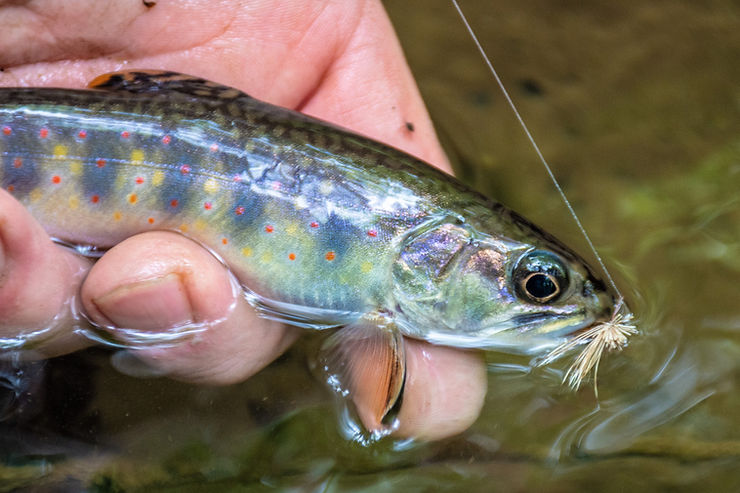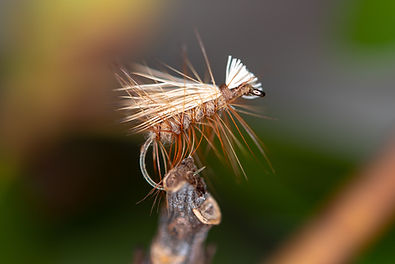Caddisflies Top to Bottom

Caddisflies are perhaps the most abundant and prolific fly hatches found on Pennsylvania trout streams. They come in a vast variety of colors and sizes, and certain species hatch virtually year-round.
Unlike traditional mayflies, which have “upright” wings that give them a sailboat appearance as they float on the surface, caddisflies are “downwings.” In fact, they have two sets of wings that lie parallel to their bodies, and they fly with the gracefulness of World War I biplanes.
Larva Stage
Even if you’ve never seined a stream bottom or visited a fly shop, you’ve probably seen remnants of caddisflies. Ever examine the contents of a trout’s stomach and find tiny pebbles and sticks and wonder how they got in there? Logic says the trout probably scooped them up accidentally while feeding on mayfly nymphs. It’s no accident, though. That debris is the remnants of the small cases which caddisflies live in during their larval stage.
This stage is best represented with basic nymphs that have a worm-like appearance. A basic pattern tied with a green, cream, or tan body and peacock herl head will imitate a number of caddis species in their larval stage. In murky water, brighter patterns such as Copper Johns imitate them well. I fish these patterns on the bottom, usually under a strike indicator.
Pupal Stage
When caddis larvae begin to emerge from their husks, they enter the pupal stage. A pocket of gas forms under their pupal skin, giving them a sparkling appearance. The gas helps propel the insect toward the surface. If you’ve ever witnessed splashy rises or trout flying up out of the water after a fly, chances are that fish was chasing an emerging caddis.
The transition from larva to adult happens in a matter of seconds. As the emerging pupa shoots toward the surface, it sheds its casing, much like a caterpillar metamorphosing into a butterfly. This casing then floats off downstream in the surface film and is sometimes eaten by trout. When fish are keying on this stage of the hatch, choose a caddis patterns with lots of sparkle and fish it near the surface or in the actual film.
Adult Stage
Adult caddisflies are sometimes confused with adult stoneflies. If you’re ever unsure, examine the position of the wings. Caddis wings appear tent-shaped whereas stonefly wings lie flat along the top of their abdomen. Adult caddisflies often have an erratic flight pattern and sometimes live for several days before finding a mate and returning to the stream to lay their eggs. Even then, some species will lay their eggs on the stream’s surface while others dive down to the bottom to complete the cycle.
The overall best pattern used to imitate any adult caddis is the Elk Hair Caddis in the correct color and size to match the emerging naturals. The Elk Hair Cadis is a Pennsylvania product, invented by fly tyer Al Toth in 1957, and it has become a must-have in just about anyone’s fly box. The Elk Hair Caddis was originally designed to withstand the rough and tumble currents of Loyalsock Creek, in Lycoming and Sullivan Counties, where Toth regularly fished, but its effectiveness is well-known worldwide.

Caddis Hatches
Like the various mayfly species, each species of caddis emerges at specific times, generally dictated by water temperature and time of year. There’s so much variance from stream to stream, but the best way to find out which species is most abundant right now is to turn over a few rocks in shallow water. On the underside of most rocks you’ll find small clusters of tiny stones. Break open those clusters and you’ll find the actual caddis larva, which will help you decide which color and size imitation to use.
Dry fly fishing over a caddis hatch can be frustrating. I’ve experienced numerous occasions where there were literally thousands of insects in the air, yet very few fish rising. Conversely, I’ve seen trout go crazy over only a handful of naturals. I’ve learned, though, that just because I can’t see trout rising doesn’t mean they’re not feeding on caddis, either in the larval or pupal stage.
Eighty percent of a trout’s diet consists of aquatic insects. Because caddisflies are so common in streams in Pennsylvania and around the country, it only makes sense that the bulk of that eighty percent is caddisflies. Learn to fish them properly and it stands to reason that you can catch trout anywhere at almost any time of year.
Sign up for the Dark Skies Fly Fishing e-newsletter
It's free, delivered to your inbox approximately three times each month. Your information is always kept private and used for the sole purpose of keeping you up to date on blog posts and specials in the online store.
Sign Up Now
I’ve really enjoyed reading your blog, especially the fly tying articles. As a kid who was ‘ate up’ with fly fishing and tying, I drifted away from it all. Now in my 60’s I’m feeling a strong pull back to it all. Thanks for great reads.
Thank you, Michael Horst! I really appreciate your feedback and support of this blog. I’m glad you’re re-experiencing the joys of fly fishing and tying.